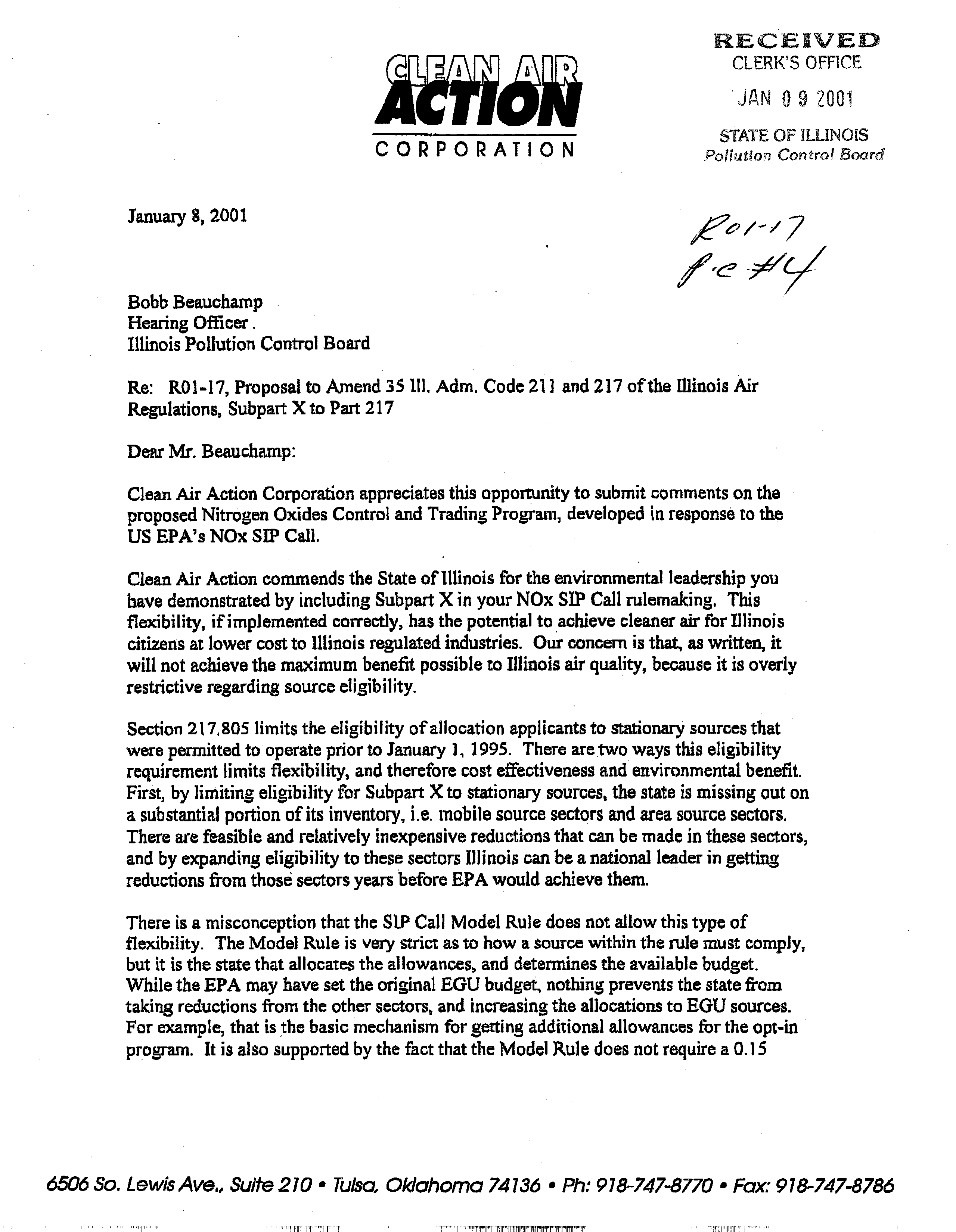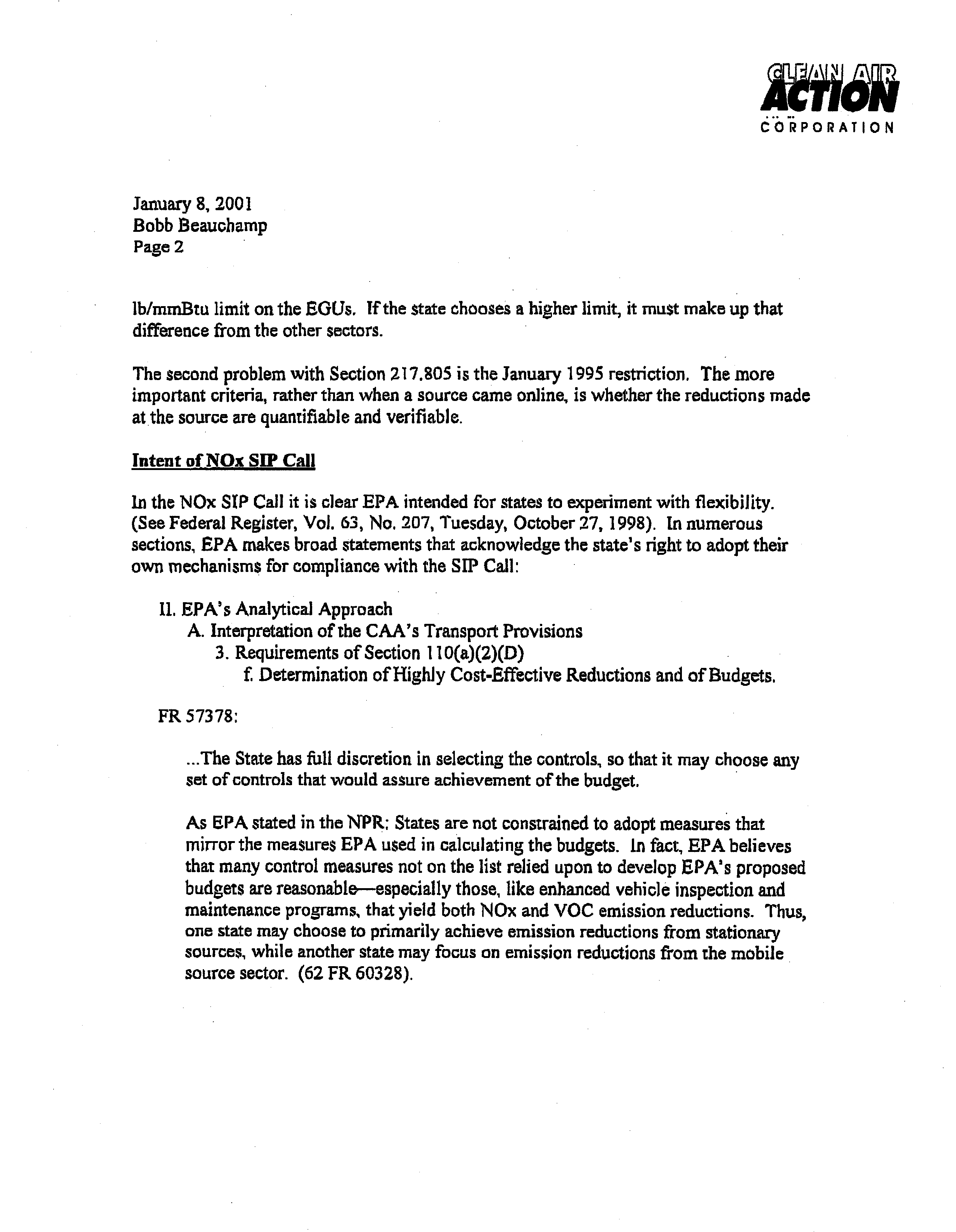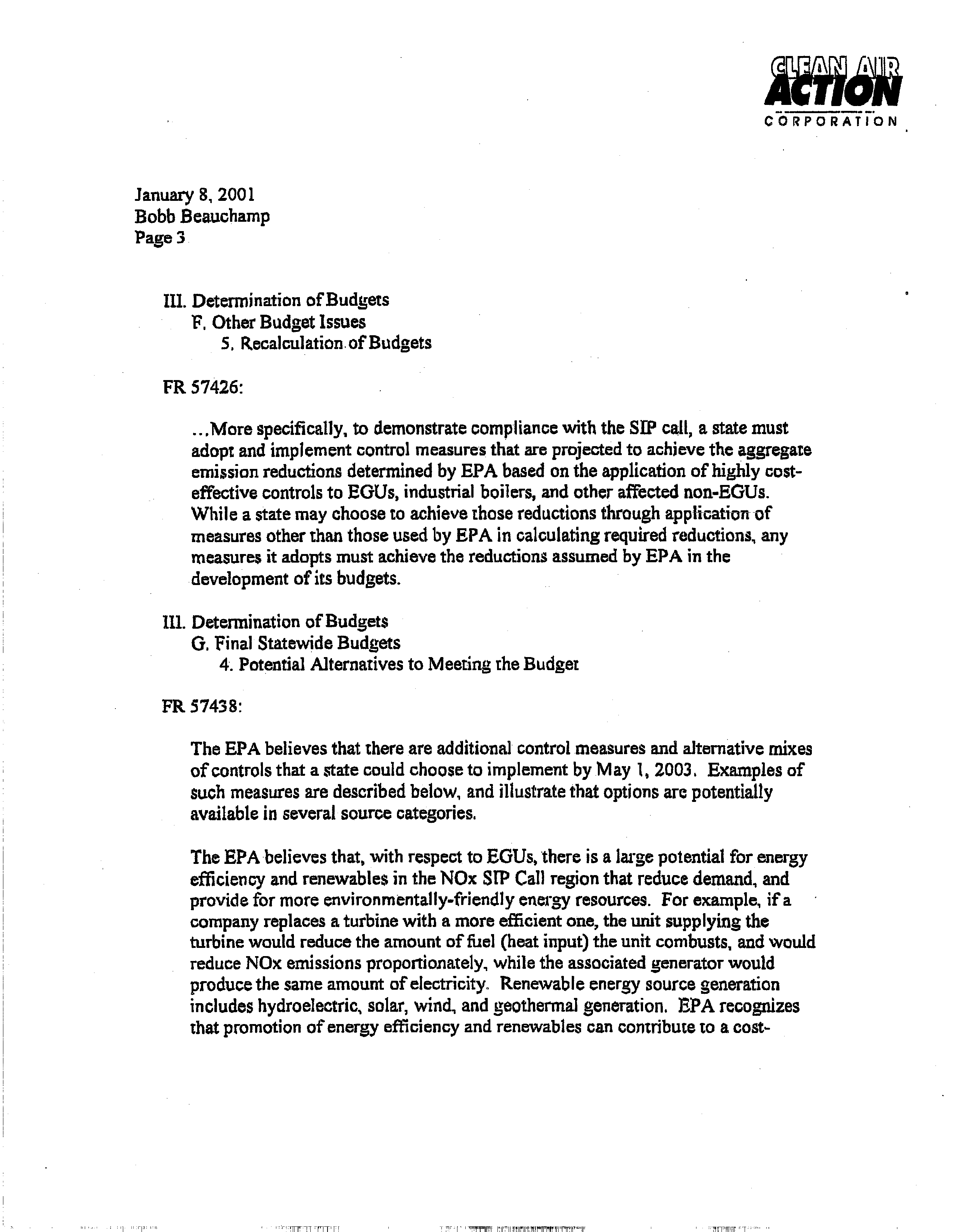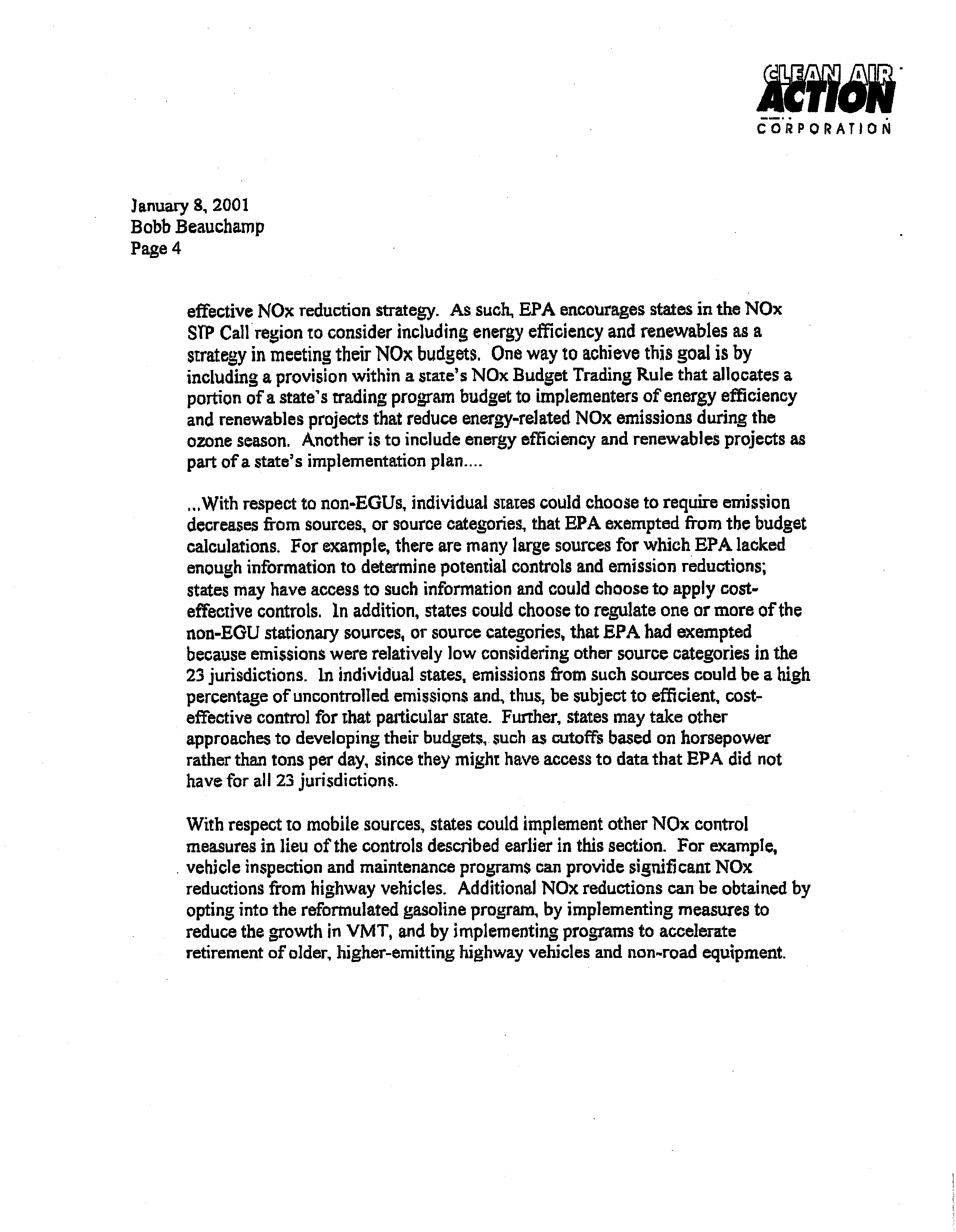RECEIVED
CLERK’S
OFFICE
Jf\N
0
9
2001
COP
P0
P
AT 10
N
STATEOFILLINOIS
Pa
flu flora
Contra
Board
January
8, 2001
Bobb Beauchamp
Hearing Officer.
Illinois Pollution Control Board
Re:
ROI-17, Proposal to Amend
35
111. Adm. Code
2.11 and 217 ofthe ilinois Air
Regulations, Subpart
X
to Part 217
Dear Mr. Beauchamp:
Clean Air Action
Corporation appreciates this opportunity to submit comments on the
proposed Nitrogen Oxides Control and Trading Program,
developed in response to the
US EPA’s NOx SIP
Call.
Clean Air Action
commends the State ofIllinois for the environmental leadership you
have demonstrated by including Subpart X in your NOx SIP Call rulemaking.
This
flexibility, ifimplemented correctly, has the potential to
achieve cleaner air for Illinois
citizens at lower cost to illinois regulated industries.
Our concern
is that, as written, it
will not achieve the maximum benefit possible to Illinois air quality,
because it is overly
restrictive regarding source eligibility.
Section 217,805 limits the eligibility ofallocation
applicantsto
stationary sources that
were permitted to operate prior to January,
1995.
There aretwo ways this eligibility
requirement limits flexibility, and therefore cost effectiveness and environmental benefit.
First,
by limiting eligibility for Subpart
X
to Stationary sources,
the state is missing out on
a substantial portion ofits inventory.
i.e. mobile source sectors and area source sectors.
There are feasible and relatively
inexpensive reductions that can be made
in these sectors,
and by expanding eligibility to these sectors illinois can be a national leader in getting
reductions from those sectors years before EPA would achieve them.
There is a misconception that the SIP Call Model Rule does not allow this type of
flexibility.
The Model Rule is
very strict asto
how a Source within the rule must comply,
but it
is the statethat allocates the allowances, and determines the available budget.
While the EPA may have set the original EGU budget, nothing prevents the state from
taking reductions from the other sectors, and increasing the allocations to EGU sources.
For example, that
is the basic mechanism for getting additional allowances for the opt-in
program.
It is also supported by the
fact
that the Model Rule does not require a 0.15
6506 So. LewisAve.. Suite 210
•
Tulsa.
Oklahoma 74136
•
Ph: 918-747-8770
•
Fax:918-747-8786
nyv
AffI
6 •6
R P0
R
AT 10
N
January 8, 2001
Bobb Beauchamp
Page 2
lb/mmBtu limit on the EGUs.
!fthe State chooses a higher limit,
it
must make up that
difference from the other sectors.
The second problem with Section 2.17.805 is the January 1995
restriction.
The
more
important criteria,
rather than when a source came online, is whether the reductions made
at the source are quantifiable and verifiable.
Intent of
NOx SLP Call
in the NOx SIP Call
it
is clear EPA intended for states to experiment with flexibility.
(See Federal Register, Vol.
63,
No. 207, Tuesday,
October 27,
1998).
In numerous
sections, SPA makes
broad statements that acknowledge the state’s
right to adopt their
own mechanisms for compliance with the SIP Call:
11. EPNs Analytical Approach
A. Interpretation ofthe CAA’s Transport Provisions
3. Requirements of Section
1 l0(a)(2)(D)
f.
Determination ofHighly Cost-Effective Reductions and of Budgets.
FR 57378:
.The State has fidi discretion
in selecting the controls, so that
it
may choose any
set ofcontrols that would assure achievement ofthe budget.
As EPA stated in the NPR: States are not constrained to adopt measures that
mirror the measures EPA used in
calculating the budgets.
In fact, EPA believes
that many control measures not on the list relied upon to develop
EPA’s proposed
budgets are reasonable—especially those, like enhanced vehicle inspection and
maintenance programs, that yield both NOx and VOC emission reductions.
Thus,
one state may choose to primarily achieve emission reductions from stationary
sources, while another state may focus on emission
reductions from the mobile
source sector.
(62 FR 60328).
mia
CO
R P0
RAT
I 0
N
January 8,
2001
Bobb
Beauchamp
Page
3
Ill. Determination ofBudgets
F.
Other Budget Issues
5.
Recalculation, ofBudgets
FR 57426:
.More specifically, to demonstrate compliance with the SiP
call, a state must
adopt and implement control measures that are projected to achieve the aggregate
emission reductions determined by EPA based on the application ofhighly cost-
effective controls to ~GUs, industrial
boilers, and other affected non-EGUs.
While a state may choose to achievethose reductions through application of
measures other than those used by EPA in calculating required reductions, any
measures it adopts must achieve the reductions assumed by EPA in the
development ofits budgets.
111. Determination ofBudgets
0. Final Statewide Budgets
4. Potential Alternatives to Meeting theBudget
FR
57438:
The EPA believes that there are additional control measures and alternative mixes
of controls that a state could choose to implement by May
1, 2003,
Examples of
such measures are described below,
and illustrate that options are potentially
available in several source categories.
The EPA believes that, with respect to EGUs, there is a large potential for energy
efficiency and renewables in the NOx
SIP Call region that reduce demand, and
provide for more environmentally-friendly energy resources.
For example, if a
company replaces a turbine with a more efficient one, the unit supplying the
turbine would reduce the amount of fuel (heat input) the unit combusts, and would
reduce NOx emissions proportionately, while the associated generator would
producethe same amount ofelectricity.
Renewable energy source generation
includes hydroelectric, solar,
wind,
and geothermal
generation.
EPA recognizes
that promotion ofenergy efficiency and renewables can contribute to a cost-
AWIE
ci
P 0
R A TI 0
N
lanuary 8, 2001
Bobb Beauchanip
Page 4
effective NO~c reduction strategy.
As such, EPA encourages states in the NOx
SIP
Call region to consider including energy efficiency and renewables
as a
strategy in
meeting their NOx budgets.
One way to achieve this goal
is
by
including a provision within a state’s NOx Budget Trading Rule that allocates a
portion ofa state’s trading program budget to ixnplementers ofenergy efficiency
and renewables projects that reduce energy-related NOx
emissions during the
ozone season.
Another is to include energy efficiency and renewables projects as
part ofa stat&s implementation plan....
• .
.With respect to non-EGUs, individual states could choose to require emission
decreases from sources,
or source categories, that EPA exempted from the budget
calculations.
For example, there are many large sources for which EPAlacked
enough information to determine potential controls and emission reductions;
states may have access to such information and could choose to apply cost-
effective controls.
in addition, states could choose to regulate one or more ofthe
non-EGU stationary sources,
or source categories, that EPA had exempted
because emissions were relatively low considering other source categories in the
23
jurisdictions,
in
individual states,
emissions from such sources could be a high
percentage of uncontrolled emissions and, thus, be subject to efficient, cost-
effective control for that particular state.
Further,
states may take other
approaches to developing their budgets,
such as cutoffs based on horsepower
rather than tons per day,
since they
might have access to data that EPA did not
have for
all 23 jurisdictions.
With respect to
mobile sources, states could implement otherNOx control
measures in lieu ofthe controls described earlier in this section.
For example,
vehicle inspection and maintenance programs can provide significant NOx
reductions from highway vehicles.
Additional NOx reductions can be obtained by
opting into the reformulated gasoline program,
by implementing measures to
reduce the growth in VMT,
and by implementing programs to accelerate
retirement ofolder, higher-emitting highway vehicles and non-road equipment.
COI~PORATION
January 8, 2001
Bobb Beauchamp
Page
5
VII. NOx Budget Trading Program
C. General Design ofNOx Budget Trading Program
2. Alternative Market Mechanisms
FR
57457:
The EPAfirst reiterates that the model program is voluntary (63 FR 25918).
In providing a cap-and-trade program as a streamlined
means by which to
comply with the NOx SIP Call, EPA does not preclude implementation of
other solutions.
The purpose ofthe trading program is to provide a
compliance mechanism that capitalizes on a proven means ofcost effectively
meeting a specific emissions budget that the Agency will
assist states in
administering.
FR
57458:
...States,
however, have the flexibility to respond as they see fit to meet their
emission budget established under the NOx SIP Call.
States are free to pursue
other regulatory mechanisms, or include othertypes oftrading programs in
their SIPs, whether newly created or already existing, on the condition that
they meet EPA’s SIP approval criteria as delineated for the NOx SEP Call.
We appreciate this opportunity to
comment on this rulemaking,
and would welcome the
opportunity to discuss
it at more length.
I can be reached at 918-747-8770.
Charles E. Williams
Vice President
~Th~T
r~I
I
I
F
T’Yfl






